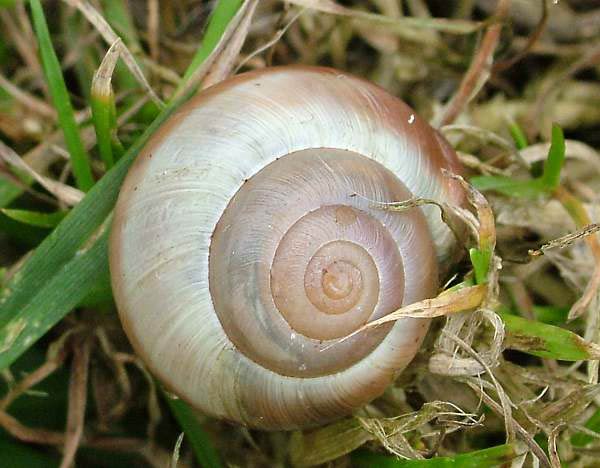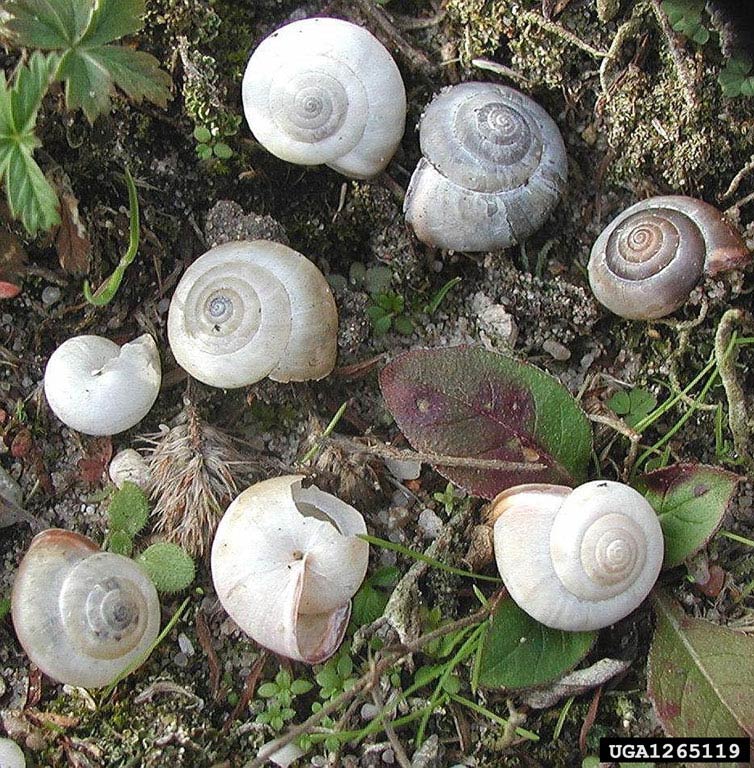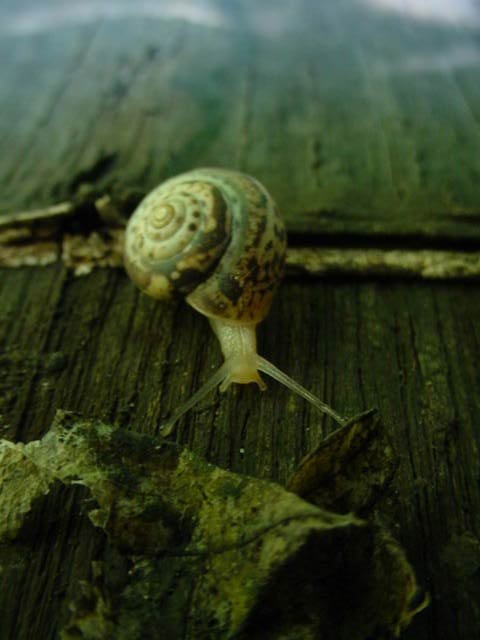Monacha spp.
|
Monacha cantiana. (Photo: © Ray Hamblett 2003-2004) |
|
Monacha cartusiana. (Photo: © L.Kolouch, www.biolib.cz) |
|
Monacha cartusiana. (Photo: © L.Kolouch, www.biolib.cz) |
|
Monacha cartusiana: juveniles. (Photo: © F. Geller-Grimm, Wikipedia) |
|
Monacha cartusiana: juveniles. (Photo: © F. Geller-Grimm, Wikipedia) |
|
Monacha cartusiana: juvenile. (Photo: © B. Sullivan, USDA-APHIS) |
Family
Hygromiidae
Species
Monacha cantiana (Montagu, 1803)
M. cartusiana (Muller, 1774)
M. syriaca (Ehrenberg, 1831)
Common name
Monacha cantiana: Kentish snail, Kentish garden snail
Monacha cartusiana: Carthusian snail, Chartreuse snail
Monacha syriaca: None reported
Description
Monacha cantiana: The medium sized shellShell:
A hard, inflexible, calcareous or chitinous structure that vary in size and may either completely encasing the animal, covering some part of it or be internal.
of this snail is 10.5 to 14 mm high and 15.5 to 20 mm wide with 5 1/2 - 6 whorlsWhorls:
Pleural of whorl. A whorl is a complete spiral turn/growth of the shell of a mollusc. The whorls are counted from the apex outwards.
. The shellShell:
A hard, inflexible, calcareous or chitinous structure that vary in size and may either completely encasing the animal, covering some part of it or be internal.
has a narrow umbilicusUmbilicus:
A navel-like indentation or depression in the center of the shell. It may be described as open (inside of columella visible), partially closed (partly covered by base of aperture) or completely closed (not visible). The width of the umbilicus is a measure of its greatest diameter.
(navel-like opening at the baseBase:
This is the lower or underside of the shell; opposite of apical.
of the shellShell:
A hard, inflexible, calcareous or chitinous structure that vary in size and may either completely encasing the animal, covering some part of it or be internal.
), is globosely depressedDepressed:
Shrunken below a certain level.
, and slightly transparent. The top of the shellShell:
A hard, inflexible, calcareous or chitinous structure that vary in size and may either completely encasing the animal, covering some part of it or be internal.
is somewhat whitish in color and becomes progressively brownish toward the baseBase:
This is the lower or underside of the shell; opposite of apical.
. This thin shellShell:
A hard, inflexible, calcareous or chitinous structure that vary in size and may either completely encasing the animal, covering some part of it or be internal.
is glossy in appearance and possess fine, weak, irregular lines and courser growth wrinkles. The apertureAperture:
The major opening of a shell that the body of the animal may be retracted.
of the shellShell:
A hard, inflexible, calcareous or chitinous structure that vary in size and may either completely encasing the animal, covering some part of it or be internal.
is broadly lunate while the lipLip:
The margin of the aperture, which may be sharp or thickened depending upon the species (Also see apertural lip).
is slightly expanded and shortly dilated at the columellar insertion. A narrow white or brown rib strengthens this insertion.
Monacha cartusiana: This species is smaller than C. cantiana. It has a shellShell:
A hard, inflexible, calcareous or chitinous structure that vary in size and may either completely encasing the animal, covering some part of it or be internal.
that is approximately 6-10 mm high and 9-17 mm wide with 5.5-6.5 whorlsWhorls:
Pleural of whorl. A whorl is a complete spiral turn/growth of the shell of a mollusc. The whorls are counted from the apex outwards.
. The shellShell:
A hard, inflexible, calcareous or chitinous structure that vary in size and may either completely encasing the animal, covering some part of it or be internal.
is pale white or pale yellow in color and may have brown stripes. The apertureAperture:
The major opening of a shell that the body of the animal may be retracted.
of the shellShell:
A hard, inflexible, calcareous or chitinous structure that vary in size and may either completely encasing the animal, covering some part of it or be internal.
may be darker than the rest of the body.
Monacha syriaca: The shellShell:
A hard, inflexible, calcareous or chitinous structure that vary in size and may either completely encasing the animal, covering some part of it or be internal.
of this species is 7-9 mm high and 8-13.5 mm wide, with 4.5-5.5 whorlsWhorls:
Pleural of whorl. A whorl is a complete spiral turn/growth of the shell of a mollusc. The whorls are counted from the apex outwards.
. The brown shellShell:
A hard, inflexible, calcareous or chitinous structure that vary in size and may either completely encasing the animal, covering some part of it or be internal.
has a white spiralSpiral:
Directional term: direction of the coils of the whorls of a shell; opposite of axial.
stripe and a white lipLip:
The margin of the aperture, which may be sharp or thickened depending upon the species (Also see apertural lip).
. The apertural lipApertural lip:
The margin of the aperture, which may be sharp or thickened depending upon the species (Also see lip).
(mouth) may be red-brown and the umbilicusUmbilicus:
A navel-like indentation or depression in the center of the shell. It may be described as open (inside of columella visible), partially closed (partly covered by base of aperture) or completely closed (not visible). The width of the umbilicus is a measure of its greatest diameter.
(navel) is closed. The body of the animal is tan to pale yellow with brown antennae.
Native range
M. cantiana: Mediterranean region and Northwestern Europe
M. cartusiana: Mediterranean region and Southeastern Europe
M. syriaca: Mediterranean region
Distribution
North America:
- U.S.: Delaware (M. cartusiana), North Carolina (M. syriaca)
- Canada: Quebec, Ontario
Europe: Netherlands, West Germany, France, England
Ecology
This group of snails prefers dry, grassy areas (e.g. road sides, pastures). Monacha cartusiana is an intermediate host for livestock parasites including that of the sheep lungworm disease. Monacha syriaca is a pest of ornamental plants in shade houses in Israel (e.g., Butcher's broom/ horse-tongue (Ruscus hypoglossum), cast-iron plant (Apidistra elatior). Both plant species are used in gardens elsewhere.
Synonyms
Monacha cantiana:
- Helix cantiana Montagu, 1803, Testace Britannica p. 422, Suppl. Pl. 23, fig. 1.; F. R. Latchford, 1885, Amer. Nat. 19: 1111.; A. W. Hanham, 1896, Nautilus, 10: 99.
- Fruticicola cantiana Montagu, W. G. Binney, 1886. 2nd Suppl. Terr. Moll., Bull. Mus.Comp. Zool., 13: 23, pl. 1, fig. 13.
- Helix cantiana var. minor Moq., Cockerell, 1889, Nautilus 3: 87.
- Theba cantiana (Montagu) , Taylor, 1917, Monogr. L. & Freshw. Moll. Brit. Is., pt. 23, p. 78.
Monacha cartusiana:
- Helix cartusiana Muller, 1774
Monacha syriaca:
- Helix syriaca (Ehrenberg, 1831)
References
Anderson 2005Anderson 2005:
Anderson, R. 2005. An annotated list of the non-marine Mollusca of Britain and Ireland. Journal of Conchology 38: 607-637.; Kantor et al. 2009Kantor et al. 2009:
Kantor, Y.I., M.V. Vinarski, A.A. Schileyko and A.V. Sysoev. 2009. Catalogue of the continental mollusks of Russia and adjacent territories. Version 2.1. (Accessed online July 20, 2010); Kerney et al. 1979Kerney et al. 1979:
Kerney, M.P., R.A.D. Cameron and G. Riley. 1979. A field guide to the land snails of Britain and North-west Europe. Collins, London. pp. 288.; Pilsbry 1939Pilsbry 1939:
Pilsbry, H. A. 1939. Land Mollusca of North America north of Mexico vol. I part 1. Academy of Natural Sciences, Philadelphia. pp. 1-574.; Robinson 1999; Robinson and Slapcinsky 2005Robinson and Slapcinsky 2005:
Robinson, D.G. and J. Slapcinsky. 2005. Recent introductions of alien land snails into North America. American Malacological Bulletin 20: 89-93.







